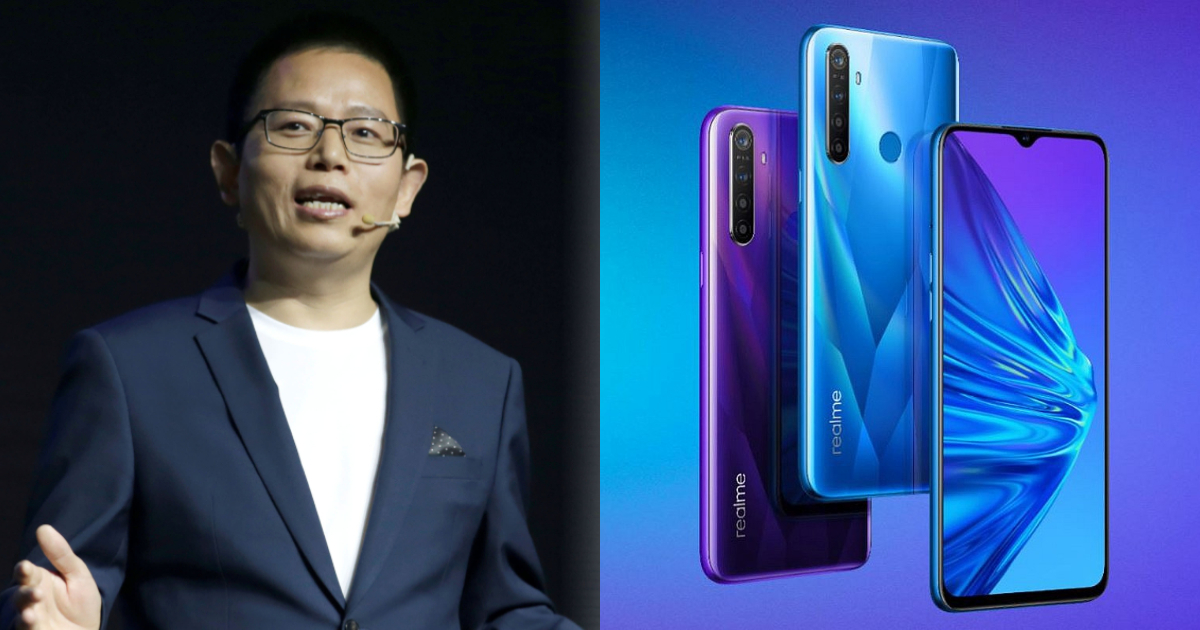At a time where the fight for market share in the global Android smartphone market was thought to be over, it is difficult to imagine a new entrant posing a significant challenge to existing smartphone brands.
This is especially so when it takes hundreds of millions of dollars in R&D as well as marketing expenses to capture market share in the competitive smartphone market.
However, over the past 2 years, a new smartphone brand has quietly snuck into the market and is slowly capturing the Android market share.
While it may not be a popular brand yet, realme has shipped 10 million phones globally in the first 14 months of its founding, a mighty feat for a young company.
In that time frame, realme has launched 11 smartphones which includes realme 1, realme 3 Pro, realme U1, realme C2 and realme X, among others.
realme’s quick ascent has led to comparisons with Xiaomi, which was one of the fastest growing budget smartphone brands few years ago.
So who exactly is behind realme, and how did its global meteoric rise take place?
An Offshoot Of Oppo
The Chinese smartphone company was founded in May 2018 by Sky Li, former vice president of Oppo.
Both Oppo and realme are owned by Chinese multinational conglomerate BBK Electronics, which also owns Vivo and OnePlus.
Although it was considered too late for a new phone brand to launch in an already crowded market back in 2018, Li was convinced that consumers between 18-25 years old were largely underserved — they needed something that was both affordable and cool.

As a marketing officer for Oppo in India before setting up realme, Li saw the opportunity to serve this group of consumers in the world’s second-largest smartphone market even though it was dominated by Xiaomi and Samsung.
In May 2018, realme released their first phone, realme 1, a budget smartphone that aims to deliver with an impressive design and sleek performance, in India.
They received great response from the Indian consumers. According to a market report released, realme quickly snatched market share from existing players and became India’s third largest smartphone phone brand at 9 per cent share within just 6 months of its launch.
realme was just behind Xiaomi and Samsung, which had 29 per cent and 25 per cent market share respectively.

In 2019, realme saw the highest annual growth rate (268 per cent) out of the top 5 smartphone brands in India, selling over 4.7 million units in the fourth quarter of 2019.
How It Sold 50M Phones In 2 Years
Building on its momentum in India, realme launched in various countries such as its homeground China and Singapore in 2019.
By July 2019, realme had successfully entered 20 markets, including South Asia, Southeast Asia and Europe.
In India alone, realme’s sales grew further by 473 per cent in 2019 with 15.7 million units sold (versus just 2.7 million in 2018), earning its top 4 spot.

In the first quarter of 2020, realme became the fastest-growing smartphone brand in Southeast Asia, with 173 per cent year-on-year growth despite the Covid-19 pandemic, according to Counterpoint Research.
As of the third quarter in 2020, the cumulative sales of realme hit 50 million units, becoming the world’s fastest smartphone brand to reach 50 million sales in just nine quarters.
It is now the world’s seventh largest smartphone brand, trailing only after those that have been around for much longer — Samsung, Huawei, Xiaomi, Apple, Oppo and Vivo, according to a 2020 Q3 report from research firm Canalys.

In Singapore, it is currently one the top five smartphone brands, with a 300 per cent increase in sales year-on-year in 2020.
The brand was also among the top 5 in terms of sales during last year’s Shopee 11.11 sales event.
The burning question is: What contributed to realme’s exponential growth?
First of all, the camera and image quality are among the big draws of realme phones. realme knew that selfies are a major selling point for their prospective target audience – the younger crowd.

To appeal to the young crowd, realme further banked on entertainment features such as different sound modes for movies, games, and music, as well as a performance-enhanced handset for gamers.
Secondly, realme, OnePlus, Oppo and Vivo are all under the same BKK Electronics umbrella, which started out in 1998 as an electronic dictionary seller in south China and has been diversifying its portfolio ever since.
While realme operates independently from the other smartphone brands, they leverage on Oppo’s supply chain, a model that has allowed them to have lighter assets and as a result, lower costs.
The light-asset (in other words, online-only) strategy also means that realme is able to offer competitive products at relatively affordable prices.
In Singapore, its 8GB RAM, 128GB phone costs S$359 and its notch screen model is priced from S$369.

Thirdly, its short distribution channels, with reduced number of intermediaries to deliver products to consumers, further help to optimise efficiency and cut costs.
In a market traditionally relying on offline sales channels and distributors, realme primarily leveraged on various online strategies targeting specific groups of users.
Furthermore, they avoid extravagant outdoor advertising to cut costs. The company prefers more subtle, word-of-mouth promotion like working with influencers, throwing campus music festivals and fostering an online fan community.

To reach the tech-savvy target users, realme relies mostly on online marketing and sales channels and this has worked very well for its young consumers.
Additionally, launching in India was a good decision as the Indian market is geared towards low-range to mid-range priced phones, which explains why Xiaomi dominates the industry while the higher-priced Apple trails behind the Chinese budget phone makers.
Had they launched in China’s fiercely competitive smartphone market, it might not have given them such as a positive headstart towards expanding to the rest of Asia.
Similiarities And Differences Of realme And Xiaomi
There is no doubt that realme’s success will spark comparisons with Xiaomi.
Founded in 2010 in Beijing and launched in more than 80 markets, Xiaomi’s success was due to its strategy of creating premium smartphones and selling them at ultra low price points.
realme also adopts this similar winning strategy.

In terms of aesthetics, realme and Xiaomi phones also look uncannily similar, making it difficult to tell them apart for a first-timer to Chinese smartphones.
When you compare similar models from both brands, you would find little differences as the features are comparable.
In fact, both brands have consistently scored similar ratings in terms of camera quality, performance and display. Both brands also sit in the S$300 price bracket.
While it seems that realme is taking a leaf out of Xiaomi’s playbook, there are differences in their strategies.
realme uses viral media and social marketing campaigns to target younger consumers like students. realme seems to target the young crowd and focus on colleges, events, cultural festivals, et cetera – a group with higher disposable income.
Xiaomi, on the other hand, targets a wider range of consumers in the age range of 18 – 65 years old.

Both realme and Xiaomi primarily use an online strategy targeting specific groups of users as well as an asset-light model. However, it is worthy to note that both brands are doubling down on their offline strategies as well, expanding the number of stores.
However, the main difference here really is realme’s access to Oppo, the third-largest smartphone maker in SEA.
realme is able to tap on Oppo’s manufacturing facilities for production, suppliers, distributors, and business development partners.
In comparison, companies like Xiaomi and Huawei hire contractors to do the work. As a result, this eats into their margins and lower their profits.
A Strong Contender As Next Xiaomi
realme is taking on Xiaomi’s Redmi and Poco budget brands, competing in the same price range.
For example, realme C2, realme 5, and realme 5 Pro compete head-to-head with Redmi A, Redmi, and Redmi Note Pro, respectively.

Even their prices and features are similar. For example, the realme 5 Pro and Xiaomi Redmi Note 7 Pro are both 48MP camera phones. Both sport the same sleek design and were launched around the same time.
The former comes with a Qualcomm Snapdragon 712 octa-core processor while the Redmi Note 7 Pro comes with a Qualcomm Snapdragon 675 octa-core processor.
| Specifications | realme 5 Pro | Xiaomi Redmi Note 7 Pro |
| Display | 6.3-inch FHD+ display with 2340×1080 pixel resolution | 6.53-inch Full HD+ Dot Notch display with 2340×1080 pixel resolution |
| Processor | Qualcomm Snapdragon 712 octa-core processor | Qualcomm Snapdragon 675 octa-core processor |
| RAM | 4GB, 6GB, 8GB | 4GB, 6GB |
| Storage | 64GB, 128GB | 64GB, 128GB |
| Rear Camera | 48MP+8MP+2MP+2MP | 48MP+5MP |
| Front Camera | 16MP | 13MP |
| Battery | 4035mAh | 4000mAh |
Both offer the same RAM and storage space options, and are in the same price bracket of S$300.
While Xiaomi has expanded from selling phones to selling gadgets such as fitness bands, laptops, earphones, TVs and so on, realme is also introducing a slew of IoT gadgets like smart TVs, smart watches and earphones.
In fact, the smartphone-plus-IoT strategy is certainly not unique as Chinese smartphone brands seem to sport the same vision: smartphones and smart devices from the same brand will form a nicely interconnected ecosystem, driving sales and data collection for each other.

Therefore, being a latecomer to the game, it is in fact an opportunity for realme to study what worked and did not work for Xiaomi.
With this, they can effectively apply these insights to their strategies, or even do better.
While realme has yet to be widely talked about in Singapore, the brand has in fact marked its entry into local telcos, Singtel, Starhub and M1 last year.
It broke into the Singapore market in late 2019 with the realme XT model that goes head-to-head with the Redmi Note 8 Pro.
Singaporean consumers can look forward to a realme concept store, coming in 2021. realme will also see the opening of a local customer service centre in Singapore, shared its Sales Director, Gavin Huang.
Furthermore, with the 5G era approaching, realme is jumping on the 5G ecosystem, forging deeper cooperation with operators, internet service providers and e-commerce platforms.
This is to ensure that young people will have access to trendsetting 5G smartphones with leap-forward technology and design at competitive price points and avoid having to incur cost to replace their smartphones when 5G is ready.
We will do our part to push forward Singapore’s nationwide effort to achieve large-scale popularisation of 5G by rapidly applying 5G technology to our product portfolio, with our sales target of 5G smartphones in 2021 to be 25 million units.
– Gavin Huang, Sales Director of realme
The meteoric rise of realme shows that smart marketing and product positioning can challenge the existing market share of the global smartphone market.
It also goes to show that it is never too late to enter a competitive market and challenge all the goliaths.
Featured Image Credit: Reuters / The Statesman









